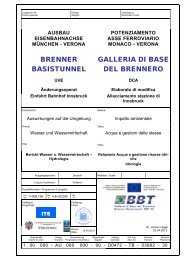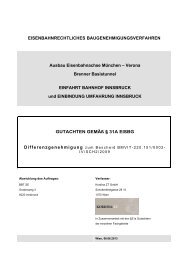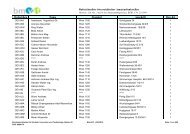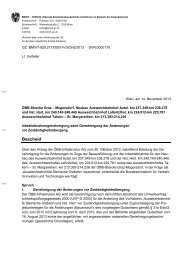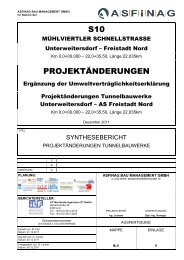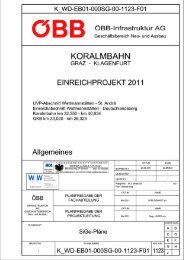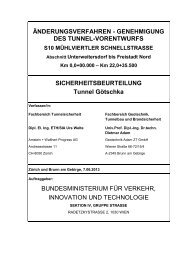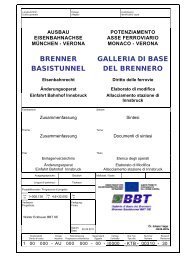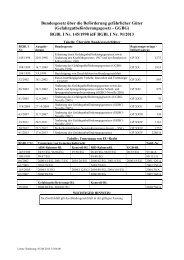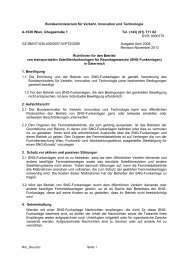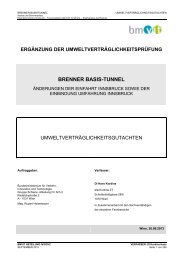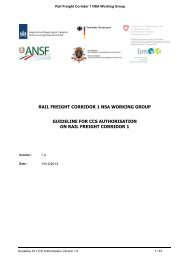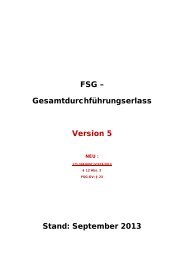Forschungsbericht "Optimierung der Feuchtsalzstreuung" [barrierearm]
Forschungsbericht "Optimierung der Feuchtsalzstreuung" [barrierearm]
Forschungsbericht "Optimierung der Feuchtsalzstreuung" [barrierearm]
Erfolgreiche ePaper selbst erstellen
Machen Sie aus Ihren PDF Publikationen ein blätterbares Flipbook mit unserer einzigartigen Google optimierten e-Paper Software.
of more than one centimetre in the relevant treatment interval with the maximum application rate of<br />
40 g/m² cannot be thawed by sodium chloride with a road temperature lower than minus 3°C purely due<br />
to physical reasons.<br />
If salt losses out of drift and discharge losses due to traffic are taken into account, the available<br />
amount of salt for thawing is significantly lower. Based on previous measurement data from [HAUS-<br />
MANN 2009; HOFFMANN et. al. 2010a], the remaining amount of salt immediately after the application<br />
process can be roughly estimated with about 50% of the initial application rate. For the given scenario<br />
above the practical available amount of de-icing agents immediately after salting can at best thaw<br />
around 0,5 cm. Dependent on the actual traffic between treatment cycles, this remaining amount of<br />
salt is scattered even further. Therefore, the road cannot be held free of snow or ice during the entire<br />
treatment interval for the afore mentioned scenario.<br />
DEVELOPED MODEL: BASE FOR AN OPTIMIZED WINTER MAINTENANCE<br />
The goal of the study was to answer the question of the necessary salt application rate and timing<br />
in or<strong>der</strong> to optimize winter maintenance and to improve the road safety. Based on extensive research,<br />
a mathematical model was developed that allows the determination of the application rate and timing<br />
of de-icing agents as a function of snow fall, traffic and road surface texture. Furthermore, the resulting<br />
skid resistance and speed limits for safe driving can be estimated based on the filling rate of the texture<br />
reserve depending on weather freezing occurs or not.<br />
The preliminary model describes the residual salt loss and the water quantity on the road based on<br />
several factors and the resulting time-dependent brine concentration. If the road surface temperature<br />
drops below the freezing point of the brine on the road, there is danger of frost. Furthermore, sleekness<br />
results only, if the brine on the road freezes and the texture reserve is insufficient. The reserve in texture<br />
depends on the macro texture of the pavement and describes the amount of frozen precipitation needed<br />
to fill the texture to interrupt direct contact of the tire with the road resulting in reduced skid resistance.<br />
The residual amount of salt is determined by resistance measurements (SOBO 20) at predetermined<br />
measurement points and is a function of application rate, traffic, road surface texture and speed. The<br />
thickness of the water film resulting from the precipitation, traffic and air temperature was measured by<br />
Vaisala - Cameras (DSC 111, DST 111). In simultaneously running measurements, the effective skid<br />
resistance and its development in various winter maintenance situations with known weather conditions<br />
and precipitation over the entire test section were examined (Grip Tester MK II). The combination of<br />
sand patch method, texture measurement by laser and RoadSTAR - data to determine the texture reserve<br />
guarantee a widespread applicability of the model on any possible road surface.<br />
PREVENTIVE TREATMENT: MECHANISM AND APPLICATION STRATEGY<br />
From the limited thawing capability of de-icing agents as well as the identified correlations in the<br />
model, the mechanism of preventive treatment can be <strong>der</strong>ived. A preventive treatment is an application<br />
of de-icing agents prior to the occurrence of a precipitation event. This serves the purpose of avoiding<br />
potentially slippery roads (e.g. hoarfrost) and eases snowploughing in the next treatment. Therefore, a<br />
preventive treatment has to be performed prior to each precipitation event. In case of hoarfrost, water<br />
vapour in the air settles on the cold road surface in form of ice. Usually hoarfrost appears in the early<br />
morning between 02:00 to 04:00 am, usually not exceeding 100 g/m². With a preventive treatment and<br />
a salt application rate of 10 g/m² timed close to the beginning of hoarfrost, a slippery road surface can<br />
be largely avoided. However, a preventive treatment in the eve the day before is not effective due to the<br />
usually occurring discharge and scattering losses.<br />
If the thaw capability of the spread salt is exceeded due to the amount of snow between two treatments<br />
cycles and the remaining snow after the first snowploughing, the development of snow slush<br />
cannot be avoided. This snow slush freezes after further dilatation of the brine on the road due to ongoing<br />
precipitation. The result is a lower skid resistance compared to a snow-covered road. In addition,<br />
it is easier for the road users to adapt their driving to an observable snow covered road than on freezing<br />
and poorly visible snow slush. In such cases a preventive application of 10 g/m² is usually sufficient to<br />
form a release coating. This release coating is to be renewed after each treatment and prevents the<br />
16


![Forschungsbericht "Optimierung der Feuchtsalzstreuung" [barrierearm]](https://img.yumpu.com/20728599/16/500x640/forschungsbericht-quotoptimierung-der-feuchtsalzstreuungquot-barrierearm.jpg)

